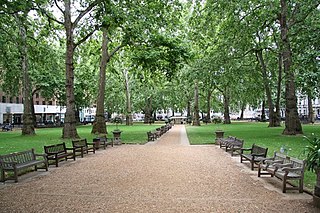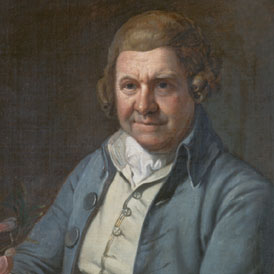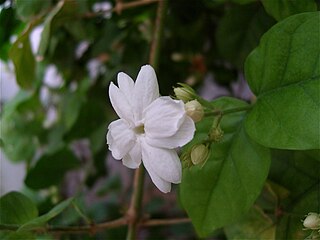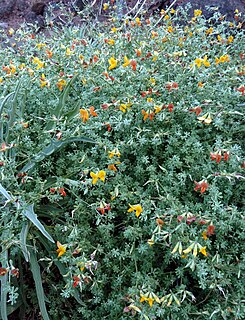
The Brassicales are an order of flowering plants, belonging to the eurosids II group of dicotyledons under the APG II system. One character common to many members of the order is the production of glucosinolate compounds. Most systems of classification have included this order, although sometimes under the name Capparales.

Brassicaceae or Cruciferae is a medium-sized and economically important family of flowering plants commonly known as the mustards, the crucifers, or the cabbage family. Most are herbaceous plants, some shrubs, with simple, although sometimes deeply incised, alternatingly set leaves without stipules or in leaf rosettes, with terminal inflorescences without bracts, containing flowers with four free sepals, four free alternating petals, two short and four longer free stamens, and a fruit with seeds in rows, divided by a thin wall.

Platanus × acerifolia, the London plane, London planetree, or hybrid plane, is a tree in the genus Platanus. It is often known by the synonym Platanus × hispanica. It is usually thought to be a hybrid of Platanus orientalis and Platanus occidentalis. Some authorities think that it may be a cultivar of P. orientalis.

William Aiton was a Scottish botanist.

Crambe is a genus of annual and perennial flowering plants in the family Brassicaceae, native to a variety of habitats in Europe, Turkey, southwest and central Asia and eastern Africa. They carry dense racemes of tiny white or yellow flowers on stems above the basal leaves. Crambe hispanica subsp. abyssinica, formerly known as Crambe abyssinica, is grown for the oil from the seeds that has characteristics similar to whale oil.

Watercress or yellowcress is a species of aquatic flowering plant in the cabbage family Brassicaceae. Its botanical name is Nasturtium officinale.

Nasturtium is a genus of seven plant species in the family Brassicaceae, best known for the edible watercresses Nasturtium microphyllum and Nasturtium officinale. Nasturtium was previously synonymised with Rorippa, but molecular evidence supports its maintenance as a distinct genus more closely related to Cardamine than to Rorippasensu stricto. Watercress or yellowcress is a common name for plants in this genus.

Pietro Andrea Gregorio Mattioli was a doctor and naturalist born in Siena.

Casuarina is a genus of 17 tree species in the family Casuarinaceae, native to Australia, the Indian subcontinent, southeast Asia, islands of the western Pacific Ocean, and eastern Africa. It was once treated as the sole genus in the family, but has been split into four genera.

Andromeda polifolia, common name bog-rosemary, is a species of flowering plant in the heath family Ericaceae, native to northern parts of the Northern Hemisphere. It is the only member of the genus Andromeda, and is only found in bogs in cold peat-accumulating areas.

Spartium junceum is the sole species in the genus Spartium. Known as the Spanish broom, rush broom or weaver's broom, it is a species of flowering plant in the family Fabaceae. It is closely related to the other brooms. There are many binomials in Spartium that are of dubious validity.

Clintonia borealis is a species of flowering plant in the lily family Liliaceae. The specific epithet borealis means "of the north," which alludes to the fact that the species tends to thrive in the boreal forests of eastern Canada and northeastern United States.

Jasminum sambac is a species of jasmine native to tropical Asia, from the Indian subcontinent to Southeast Asia. It is cultivated in many places, especially across much of South and Southeast Asia. It is naturalised in many scattered locales: Mauritius, Madagascar, the Maldives, Christmas Island, Chiapas, Central America, southern Florida, the Bahamas, Cuba, Hispaniola, Jamaica, Puerto Rico, and the Lesser Antilles.

Barbarea vulgaris, also called bittercress, herb barbara, rocketcress, yellow rocketcress, winter rocket, yellow rocket, and wound rocket, is a biennial herb of the genus Barbarea, belonging to the family Brassicaceae.

Tropidocarpum is a genus of flowering plants in the family Brassicaceae. There are two to four species, one of which is extremely rare. Tropidocarpum capparideum, the caper-fruited tropidocarpum, is a plant endemic to California generally considered to be extinct since the 1950s, but has been reported since. Specimens were collected at Fort Hunter Liggett, California, in 2000 and 2001. Its status is currently in debate. The other member of the genus, the dobie pod, T. gracile, is a common mustardlike plant in California and Baja California. It is proposed that two other plants in separate monotypic genera, Twisselmannia and Agallis, be moved to Tropidocarpum.
Ihsan Ali Al-Shehbaz, Ph.D. is an Iraqi American botanist who works as Adjunct Professor at University of Missouri-St. Louis and Senior Curator at Missouri Botanical Garden. Al-Shehbaz's primary area of interest is Brassicaceae and The Durango Herald called him "a world expert on taxonomy of the family". A 2008 publication of the United States Fish and Wildlife Service called him "the world's authority on species in the genus Lesquerella". The author abbreviation "Al-Shehbaz" is attached to the numerous botanical taxa he has identified.

Sibara filifolia, the Santa Cruz Island winged rockcress or Santa Cruz Island rockcress, is a rare species of flowering plant in the family Brassicaceae. It is endemic to the Channel Islands of California, where it is now known from a few occurrences on San Clemente Island and one population on Catalina Island.

Alnus serrulata, the hazel alder or smooth alder, is a thicket-forming shrub in the family Betulaceae. It is native to eastern North America and can be found from western Nova Scotia and southern New Brunswick south to Florida and Texas.

Lotus glaucus is a species of flowering plant in the family Fabaceae, native to Madeira and the Salvage Islands. It is a perennial herbaceous plant with leaves made up of five leaflets. Its flowers are usually orange on opening. Lotus tenellus is included in a more broadly circumscribed L. glaucus by some authors, which extends its distribution to the Canary Islands.


















